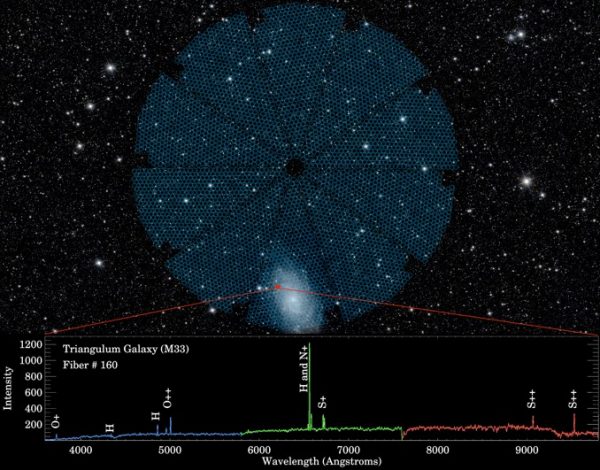5000 electronic “eyes” poised to map the effects of dark energy – Astronomy Now Online

Astronomers have collected a “first light” image from the 4-metre Mayall telescope and the 11-ton Dark Energy Spectroscopic Instrument, or DESI, equipped with 5,000 fiber optic “eyes” feeding a bank of 10 spectrographs. The system is capable of breaking down the light from 5,000 galaxies every 20 minutes to determine their distances and velocities.
The goal of the project, starting early next year, is to pin down the positions and distances to 35 million galaxies spread across one third of the sky to glean clues about the nature of the mysterious “dark energy” causing the expansion of the universe to accelerate.
With a field of view of 8 square degrees – about 40 times the area of the full moon – DESI can assess more than 100,000 galaxies in a single night.
“After a decade in planning and R&D, installation and assembly, we are delighted that DESI can soon begin its quest to unravel the mystery of dark energy,” said DESI Director Michael Levi of the U.S. Department of Energy’s Lawrence Berkeley National Laboratory. ”Most of the Universe’s matter and energy are dark and unknown, and next-generation experiments like DESI are our best bet for unraveling these mysteries. I am thrilled to see this new experiment come to life.”
A collaboration of nearly 500 researchers at 75 institutions in 13 countries, DESI is installed at the prime focus of the Mayall telescope at the Kitt Peak National Observatory in Arizona, using a 5-ton set of lenses to expand the field of view.
Behind those lenses in DESI’s focal plane are 5,000 robotic positioners, each one holding a fiber-optic cable the width of a human hair. All 5,000 can be repositioned in seconds to study a different target field, feeding the collected light to the spectrographs over a combined 150 miles of fiber optic cable.
By analysing the captured spectra, DESI will be able to calculate how fast each galaxy is moving, building up a three-dimensional map.
“Despite its age, the well-maintained Mayall telescope is the perfect platform for DESI,” said David Sprayberry, Kitt Peak site director for DESI. “Because it was originally designed for a wide field, the Mayall’s optical design was easily adapted to the very wide field-of-view needed for DESI. The telescope is also sturdy enough to carry DESI’s massive weight.”
DESI will study the effects of dark energy by mapping 35 million galaxies and 2.4 million quasars across cosmic history back to within a few billion years of the big bang.
“Galaxies aren’t scattered randomly in space, but instead form a complex pattern from which we can learn about the composition and history of the universe,” said Daniel Eisenstein of the Harvard and Smithsonian Center for Astrophysics. “The unprecedented maps from DESI will allow us to measure how the universe has expanded over time, to see how gravity and dark energy compete to pull and push material apart.”





